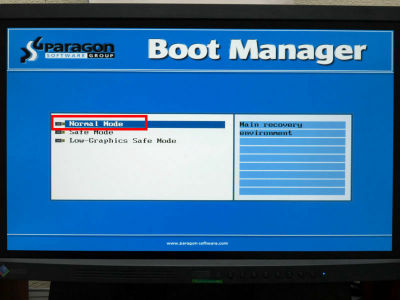I tried using 'Paper Enigma Machine' which can reproduce Nazi Germany's masterpiece encryption machine Enigma with only one sheet of paper

'
Paper Enigma.xls --paper Enigma.pdf
https://www.apprendre-en-ligne.net/crypto/bibliotheque/PDF/paperEnigma.pdf
The Paper Enigma Machine looks like this. You can use it just by printing it from the distribution page .

The upper left part is the area where Paper Enigma Machine encrypts and decrypts. There is a reflector on the left end and an input / output field for characters to be encrypted / decrypted on the right end.
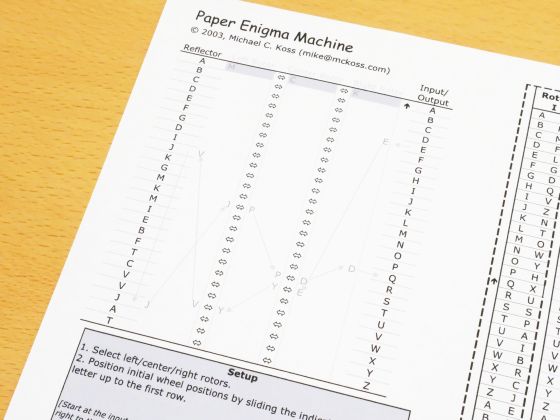
How to use and example sentences are written in the lower left.

On the right side, there are three imitations of the Enigma rotor. Each rotor has alphabets written in alphabetical order on the left and randomly on the right.
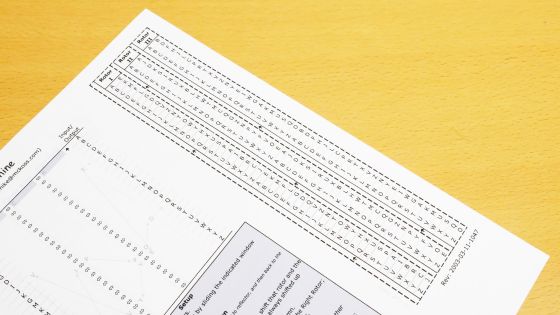
First, cut off the rotor with scissors to use the Paper Enigma Machine.

It is OK if you can make three rotors, 'Rotor I', 'Rotor II' and 'Rotor III' as shown below. That's all you need to do before using the Paper Enigma Machine.
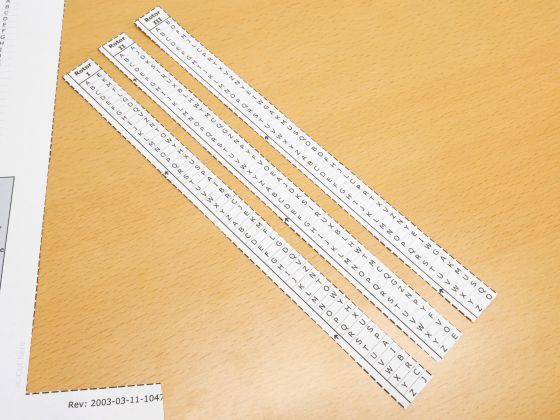
First, try decoding the example sentence 'QMJIDO MZWZJFJR'. It is said that this example sentence is encrypted with the initial setting 'I-II-III: MCK'. By decrypting with the same initial settings as when the code was created, the example sentence, which is just a character string, becomes a meaningful sentence.
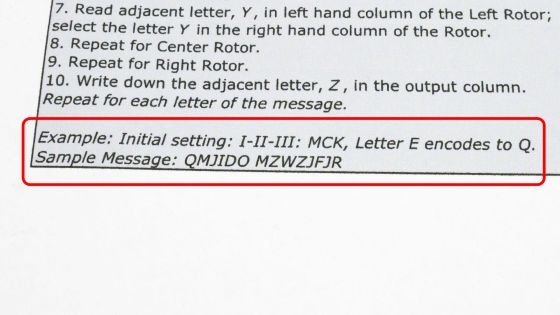
So, I will adjust the rotor to the initial setting 'I-II-III: MCK'. 'I-II-III' indicates the order in which the rotors are placed, and it is OK to arrange 'Rotor I', 'Rotor II', and 'Rotor III' in order from the left.
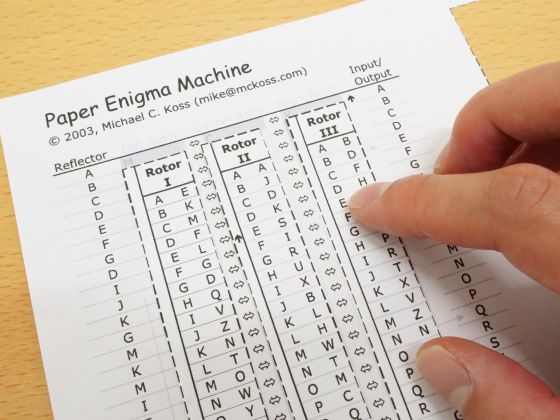
'MCK' indicates the starting position of the rotor. As shown in the image below, place the rotor so that the 'M', 'C', and 'K' parts of the alphabet written on the left side of the rotor are directly below the horizontal line drawn on the Paper Enigma Machine.

When the three rotors are set to the initial setting 'I-II-III: MCK', the image below is obtained. When this happens, you are ready to break the code.

Now, let's decipher from the first letter 'Q' of the example sentence 'QMJIDO MZWZJFJR'. With Paper Enigma Machine, it is necessary to move the rightmost rotor up one step before decoding for each character. In this case, it is OK if it shifts from 'K' by one step to 'L'. In the original Enigma, the rotor rotates by one character each time one character is deciphered, but by moving the paper by hand, the operation of the original Enigma is reproduced.

Next, search for 'Q' in the input / output column on the right side of the rotor, search for the same character written in the right column of 'Rotor III' to the left of it, and then search for the same character in the left column, and then '' to the left of it. Search for the same characters written on 'Rotor II' in the left column, and so on until you reach the leftmost reflector. This time I arrived at 'J'.

This time, I searched for another 'J' in the reflector, and when I followed the letters in the opposite direction, I arrived at the 'E' in the input / output column. In other words, when 'Q' was deciphered, it became 'E'.

Make a note of the decryption result so that you do not forget it.
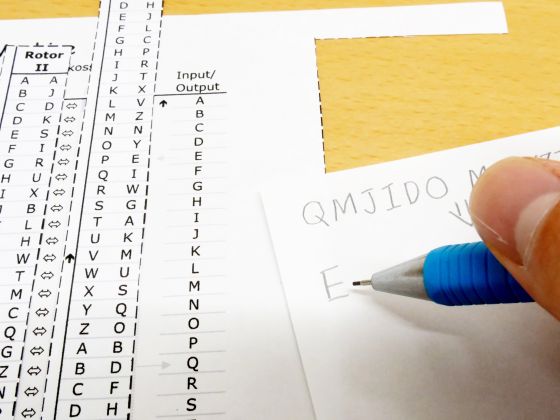
Basically, you can decipher by shifting the rightmost rotor one step up and repeating the same thing before decoding, but there are some caveats. When the rightmost rotor is moved up one step at a time, if the '↑' mark drawn on the rotor enters the encryption / decryption area ...

The rotor on the left also needs to be moved up one step. Every time the rotor of the original Enigma makes one lap, the rotor on the left also reproduces the movement of one character.

Furthermore, if you are decrypting a long sentence, the '↑' mark on the rotor in the middle will enter the encryption / decryption area ...

Similarly, you can move the rotor on the left one step up.
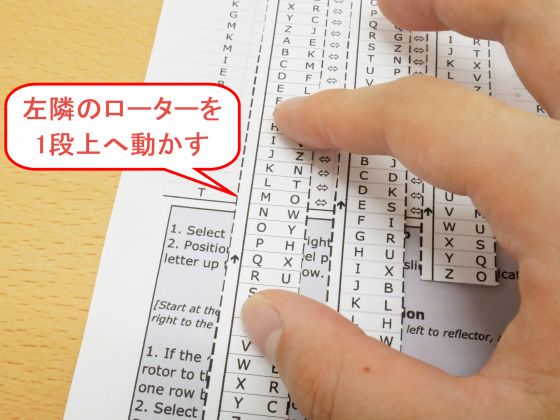
Also, since the rotor of the original Enigma is circular, it keeps spinning and can decipher any number of characters, but the rotor of the Paper Enigma Machine has a lower end. If you're decoding a long sentence and you've read everything down to the bottom of the rotor ...

Reset the top edge of the rotor to the top edge of the sheet and continue decoding.
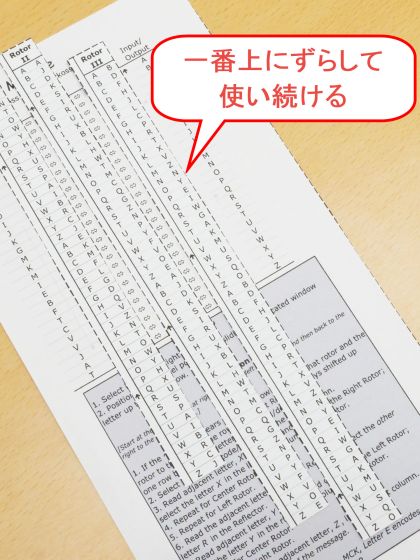
By deciphering the example sentence 'QMJIDO MZWZJFJR' while paying attention to the above points, I was able to read the English sentence 'ENIGMA REVEA LED (mystery was solved)'.

Next, let's try encryption. To encrypt 'GIGAZINE' with the initial setting 'III-I-II: GIG'. Just like decoding, place the rotor according to the initial settings and you're ready to go.

The encryption procedure is the same as for decryption. Follow the characters from the input / output field and make a note of the characters in the output field.
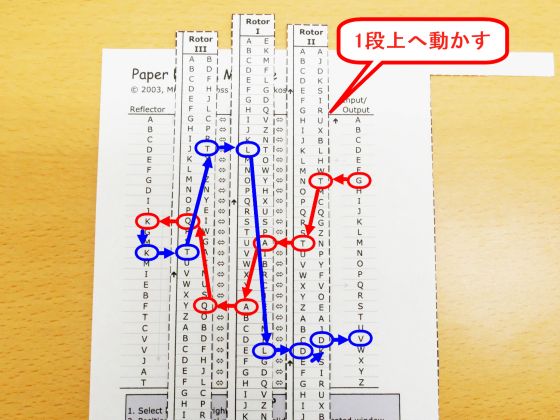
When I encrypted 'GIGAZINE' with the initial setting 'III-I-II: GIG', I was able to get the character string 'VBXGMUPW'. If you decrypt this with the same initial settings, you can get the character string 'GIGAZINE'.
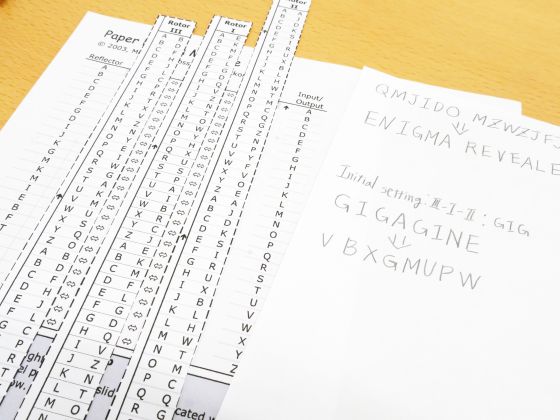
If the initial settings are different, the encryption / decryption results will change. Paper Enigma Machine has 6 rotors ...
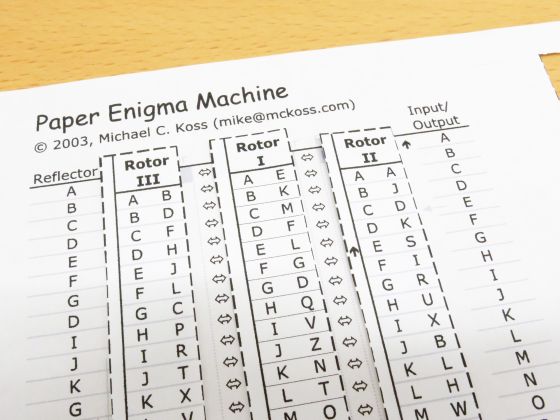
Since the start position of each rotor can be selected from 26 x 26 x 26 = 17,576 ways, it is possible to make initial settings of 6 x 17,576 = 140,608 ways. Therefore, even if the ciphertext is found to have been created by Paper Enigma Machine, it is unlikely that the ciphertext will be decrypted unless the initial settings are found.
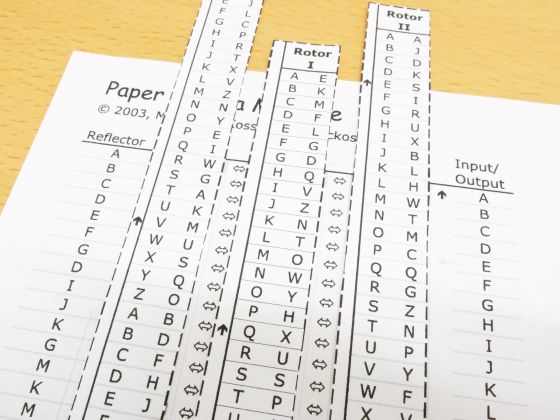
Even with the Paper Enigma Machine, which reproduces the basic system with just one sheet of paper, it is quite difficult to break the code, but it seems that the German army was operating while exchanging the alphabetical arrangement of each rotor of Enigma. It can be said that it was very difficult to break the ciphertext.
Related Posts:
in Review, Posted by log1o_hf







